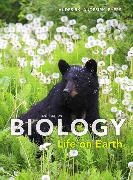Condividi
Fr. 192.50
Gerald Audesirk, Teresa Audesirk, Bruce E. Byers
Biology
Inglese · Prodotto multimediale
Spedizione di solito entro 3 a 5 settimane
Descrizione
Sommario
1. An Introduction to Life on Earth
I. THE LIFE OF THE CELL
2. Atoms, Molecules, and Life
3. Biological Molecules
4. Cell Structure and Function
5. Cell Membrane Structure and Function
6. Energy Flow in the Life of a Cell
7. Capturing Solar Energy: Photosynthesis
8. Harvesting Energy: Glycolysis and Cellular Respiration
II. INHERITANCE
9. The Continuity of Life: Cellular Reproduction
10. Patterns of Inheritance
11. DNA: The Molecule of Heredity
12. Gene Expression and Regulation
13. Biotechnology
III. EVOLUTION AND DIVERSITY OF LIFE
14. Principles of Evolution
15. How Populations Evolve
16. The Origin of Species
17. The History of Life
18. Systematics: Seeking Order Amid Diversity
19. The Diversity of Prokaryotes and Viruses
20. The Diversity of Protists
21. The Diversity of Plants
22. The Diversity of Fungi
23. Animal Diversity I: Invertebrates
24. Animal Diversity II: Vertebrates
IV. BEHAVIOR AND ECOLOGY
25. Animal Behavior
26. Population Growth and Regulation
27. Community Interactions
28. Energy Flow and Nutrient Cycling in Ecosystems
29. Earth’s Diverse Ecosystems
30. Conserving Earth’s Biodiversity
V. ANIMAL ANATOMY AND PHYSIOLOGY
31. Homeostasis and the Organization of the Animal Body
32. Circulation
33. Respiration
34. Nutrition and Digestion
35. The Urinary System
36. Defense Against Disease
37. Chemical Control of the Animal Body: The Endocrine System
38. The Nervous System
39. The Senses
40. Action and Support: The Muscles and Skeleton
41. Animal Reproduction
42. Animal Development
VI. PLANT ANATOMY AND PHYSIOLOGY
43. Plant Anatomy and Nutrient Transport
44. Plant Reproduction and Development
45. Plant Responses to the Environment
Biology Life on Earth, Tenth Edition includes Chapters 1–30
Biology Life on Earth with Physiology, Tenth Edition includes Chapters 1–45
Info autore
TERRY AND GERRY AUDESIRK
grew up in New Jersey, where they met as undergraduates. After marrying in 1970, they moved to California, where Terry earned her doctorate in marine ecology at the University of Southern California and Gerry earned his doctorate in neurobiology at the California Institute of Technology. As postdoctoral students at the University of Washington’s marine laboratories, they worked together on the neural bases of behavior, using a marine mollusk as a model system.
They are now emeritus professors of biology at the University of Colorado Denver, where they taught introductory biology and neurobiology from 1982 through 2006. In their research, funded primarily by the National Institutes of Health, they investigated the mechanisms by which neurons are harmed by low levels of environmental pollutants and protected by estrogen.
Terry and Gerry share a deep appreciation of nature and of the outdoors. They enjoy hiking in the Rockies, walking near their home in Steamboat Springs, and attempting to garden at 7,000 feet in the presence of hungry deer and elk. They are long-time members of many conservation organizations. Their daughter, Heather, provides another welcome focus to their lives.
BRUCE E. BYERS
is a midwesterner transplanted to the hills of western Massachusetts, where he is a professor in the biology department at the University of Massachusetts, Amherst. He’s been a member of the faculty at UMass (where he also completed his doctoral degree) since 1993. Bruce teaches introductory biology courses for both nonmajors and majors; he also teaches courses in ornithology and animal behavior.
A lifelong fascination with birds ultimately led Bruce to scientific exploration of avian biology. His current research focuses on the behavioral ecology of birds, especially on the function and evolution of the vocal signals that birds use to communicate. The pursuit of vocalizations often takes Bruce outdoors, where he can be found before dawn, tape recorder in hand, awaiting the first songs of a new day.
Riassunto
Biology: Life on Earth with Physiology, Tenth Edition continues this book’s tradition of engaging non-majors biology students with real-world applications, high-interest case studies, and inquiry-based pedagogy that fosters a lifetime of discovery and scientific literacy.
Maintaining the friendly writing style that has made the book a best-seller, the Tenth Edition continues to incorporate true and relevant stories using a chapter-opening Case Study that is revisited throughout the chapter and concluded at the end of the chapter. New to the Tenth Edition are Learning Goals and Check Your Learning questions that help students assess their understanding of the core concepts in biology. To increase the book’s focus on health science, additional Health Watch essays are provided throughout units, and more anatomy & physiology content has been incorporated into the main narrative. Other highlights include new or revised Consider This questions, Have You Ever Wondered? Questions, and MasteringBiology.
For coverage of plant and animal anatomy & physiology, an alternate edition—Biology: Life on Earth with Physiology, Tenth Edition—is also available.
Dettagli sul prodotto
| Autori | Gerald Audesirk, Teresa Audesirk, Bruce E. Byers |
| Editore | Pearson Academic |
| Lingue | Inglese |
| Formato | Prodotto multimediale |
| Pubblicazione | 01.01.2013 |
| EAN | 9780321834195 |
| ISBN | 978-0-321-83419-5 |
| Pagine | 500 |
| Peso | 1580 g |
| Serie |
Benjamin Cummin Benjamin Cummin |
| Categoria |
Scienze naturali, medicina, informatica, tecnica
> Biologia
> Tematiche generali, enciclopedie
|
Recensioni dei clienti
Per questo articolo non c'è ancora nessuna recensione. Scrivi la prima recensione e aiuta gli altri utenti a scegliere.
Scrivi una recensione
Top o flop? Scrivi la tua recensione.

